Development of Intelligent and Active Gelatin-Based Packaging Film Incorporating Red Onion Anthocyanins and Encapsulated Citronella Oil
Abstract
1. Introduction
2. Materials and Methods
2.1. Materials
2.2. Extraction of Red Onion Skins Anthocyanins
2.3. Preparation and Characterization of OBDs
2.4. Preparation and Characterization of Composite Films
2.4.1. Preparation of Composite Films
2.4.2. Physicochemical Properties of Composite Films
2.4.3. Antioxidant Activity of Composite Films
2.4.4. Antibacterial Activity and Mechanism of Composite Films
2.4.5. Biosafety Testing, Degradation Testing and Release of CEO of Composite Films
2.4.6. pH-Responsive and Color Stability of Composite Films
2.4.7. Ammonia-Sensitive Performance of Composite Films
2.5. Application of Composite Films
2.6. Statistical Analysis
3. Results and Discussion
3.1. Characterization of OBDs
3.2. Antioxidant and Antibacterial Activity of OBDs
3.3. UV-Vis Spectroscopy of Anthocyanins
3.4. Characterization of Films
3.5. Thermal Stability of Films
3.6. Optical Properties of Films
3.7. Barrier Properties and Mechanical Properties
3.8. Antioxidant Activity of Films
3.9. Antibacterial Activity of Films
3.10. Biosafety and Degradability of Films
3.11. Release of CEO
3.12. pH-Responsive and Color Stability of Films
3.13. Ammonia-Sensitive Performance
3.14. Application of Films
4. Conclusions
Supplementary Materials
Author Contributions
Funding
Institutional Review Board Statement
Informed Consent Statement
Data Availability Statement
Conflicts of Interest
Abbreviations
| CEO | Citronella essential oil |
| ROSA | Red onion skins for the extraction of anthocyanins |
| β-CD | β-cyclodextrin |
| OBDs | Encapsulation of CEO within β-cyclodextrin |
| GEL | Gelatin |
| CAR | κ-carrageenan |
| CG | a κ-carrageenan/gelatin-based composite film |
| CGR | a κ-carrageenan/gelatin-based composite film incorporating ROSA |
| CGR/OBDs | a κ-carrageenan/gelatin-based composite film incorporating ROSA and OBDs |
| SEM | scanning electron microscopy |
| FTIR | Fourier-transform infrared spectroscopy |
| XRD | X-ray diffraction |
| S. aureus | Staphylococcus aureus |
| E. coli | Escherichia coli |
References
- Tomas, M.; Kamiloglu, S.; Nemli, E.; Ozdal, T.; Haque, S.; Apak, R.; Capanoglu, E. From carotene-rich waste-to-food: Extraction, food applications, challenges and opportunities. Trends Food Sci. Technol. 2025, 155, 104756. [Google Scholar] [CrossRef]
- Qiao, J.; Zhang, M.; Qiu, L.; Mujumdar, A.S.; Ma, Y. Visual early warning and prediction of fresh food quality deterioration: Research progress and application in supply chain. Food Biosci. 2024, 58, 103671. [Google Scholar] [CrossRef]
- He, X.; Pu, Y.; Chen, L.; Jiang, H.; Xu, Y.; Cao, J.; Jiang, W. A comprehensive review of intelligent packaging for fruits and vegetables: Target responders, classification, applications, and future challenges. Compr. Rev. Food Sci. Food Saf. 2023, 22, 842–881. [Google Scholar] [CrossRef] [PubMed]
- Uysal-Unalan, I.; Sogut, E.; Realini, C.E.; Cakmak, H.; Oz, E.; Espinosa, E.; Morcillo-Martín, R.; Oz, F.; Nurmi, M.; Cerqueira, M.A.; et al. Bioplastic packaging for fresh meat and fish: Current status and future direction on mitigating food and packaging waste. Trends Food Sci. Technol. 2024, 152, 104660. [Google Scholar] [CrossRef]
- Akhila, K.; Ramakanth, D.; Lakshman Rao, L.; Singh, S.; Gaikwad, K.K. Plant phytochemicals as bio-responsive compounds in smart packaging for food spoilage detection: A comprehensive review. Sustain. Food Technol. 2024, 2, 860–875. [Google Scholar] [CrossRef]
- Alves, J.; Gaspar, P.D.; Lima, T.M.; Silva, P.D. What is the role of active packaging in the future of food sustainability? A systematic review. J. Sci. Food Agric. 2023, 103, 1004–1020. [Google Scholar] [CrossRef]
- Pang, H.; Wu, Y.; Tao, Q.; Xiao, Y.; Ji, W.; Li, L.; Wang, H. Active cellulose acetate/purple sweet potato anthocyanins@cyclodextrin metal-organic framework/eugenol colorimetric film for pork preservation. Int. J. Biol. Macromol. 2024, 263, 130523. [Google Scholar] [CrossRef]
- Gomes, B.T.; Rodrigues Borges, L.L.; de Leon da Costa, N.M.E.P.; Arruda, T.R.; Ribeiro, A.R.C.; Marques, C.S.; Stringheta, P.C.; de Oliveira, T.V.; Soares, N.d.F.F. Gelatin/polyvinyl alcohol films incorporated with different blueberry extracts as potential colorimetric indicators to detect acidic and basic vapors. Food Control 2024, 165, 110648. [Google Scholar] [CrossRef]
- Sadi, A.; Ferfera-Harrar, H. Cross-linked CMC/Gelatin bio-nanocomposite films with organoclay, red cabbage anthocyanins and pistacia leaves extract as active intelligent food packaging: Colorimetric pH indication, antimicrobial/antioxidant properties, and shrimp spoilage tests. Int. J. Biol. Macromol. 2023, 242, 124964. [Google Scholar] [CrossRef]
- Panwar, A.; Kumar, S.; Dhiman, A.; Kumar, V.; Gupta, D.; Sharma, A. pH sensitive indicator film based intelligent packaging systems of perishables: Developments and challenges of last decade. Microchem. J. 2024, 207, 111732. [Google Scholar] [CrossRef]
- Wei, M.; Shan, M.; Zhang, L.; Chen, N.; Tie, H.; Xiao, Y.; Li, Z. Preparation of gelatin/ĸ-carrageenan active films through procyanidins crosslinking: Physicochemical, structural, antioxidant and controlled release properties. Food Hydrocoll. 2024, 153, 110023. [Google Scholar] [CrossRef]
- Pierpoint, B.J. o-Quinones formed in plant extracts. Their reactions with amino acids and peptides. Biochmical J. 1969, 112, 609–616. [Google Scholar] [CrossRef] [PubMed]
- Arcan, I.; Yemenicioğlu, A. Incorporating phenolic compounds opens a new perspective to use zein films as flexible bioactive packaging materials. Food Res. Int. 2011, 44, 550–556. [Google Scholar] [CrossRef]
- Chadorshabi, S.; Hallaj-Nezhadi, S.; Ghasempour, Z. Red onion skin active ingredients, extraction and biological properties for functional food applications. Food Chem. 2022, 386, 132737. [Google Scholar] [CrossRef]
- Sundar, S.K.; Parikh, J.K. Advances and trends in encapsulation of essential oils. Int. J. Pharm. 2023, 635, 122668. [Google Scholar] [CrossRef]
- Gonçalves, S.; Castro, J.; Almeida, A.; Monteiro, M.; Rodrigues, T.; Fernandes, R.; Matos, R.S. A systematic review of the therapeutic properties of lemon essential oil. Adv. Integr. Med. 2025, 12, 100433. [Google Scholar] [CrossRef]
- Zhao, C.; Zhang, Z.; Nie, D.; Li, Y. Protective Effect of Lemon Essential Oil and Its Major Active Component, D-Limonene, on Intestinal Injury and Inflammation of E. coli-Challenged Mice. Front. Nutr. 2022, 9, 843096. [Google Scholar] [CrossRef]
- Devi, L.S.; Das, B.; Dutta, D.; Kumar, S. Essential oils as functional agents in biopolymer-based sustainable food packaging system: A review. Sustain. Chem. Pharm. 2024, 39, 101563. [Google Scholar] [CrossRef]
- Gao, M.; Ji, M.; He, Y.; Pan, X.; Wang, Y.; Si, T.; Sun, Y. Construction of consumer-friendly essential oil microcapsules with viscous cores to provide extra long-lasting release. Powder Technol. 2023, 413, 118040. [Google Scholar] [CrossRef]
- Liu, Q.; Huang, H.; Chen, H.; Lin, J.; Wang, Q. Food-Grade Nanoemulsions: Preparation, Stability and Application in Encapsulation of Bioactive Compounds. Molecules 2019, 24, 4242. [Google Scholar] [CrossRef]
- Yousefi, S.; Weisany, W.; Hosseini, S.E.; Ghasemlou, M. Mechanisms of nanoencapsulation to boost the antimicrobial efficacy of essential oils: A review. Food Hydrocoll. 2024, 150, 109655. [Google Scholar] [CrossRef]
- Paiva-Santos, A.C.; Ferreira, L.; Peixoto, D.; Silva, F.; Soares, M.J.; Zeinali, M.; Zafar, H.; Mascarenhas-Melo, F.; Raza, F.; Mazzola, P.G.; et al. Cyclodextrins as an encapsulation molecular strategy for volatile organic compounds—Pharmaceutical applications. Colloids Surf. B Biointerfaces 2022, 218, 112758. [Google Scholar] [CrossRef]
- Li, X.; Sha, X.-M.; Yang, H.-S.; Ren, Z.-Y.; Tu, Z.-C. Ultrasonic treatment regulates the properties of gelatin emulsion to obtain high-quality gelatin film. Food Chem. X 2023, 18, 100673. [Google Scholar] [CrossRef] [PubMed]
- Lv, L.-C.; Huang, Q.-Y.; Ding, W.; Xiao, X.-H.; Zhang, H.-Y.; Xiong, L.-X. Fish gelatin: The novel potential applications. J. Funct. Foods 2019, 63, 103581. [Google Scholar] [CrossRef]
- Aga, M.B.; Dar, A.H.; Nayik, G.A.; Panesar, P.S.; Allai, F.; Khan, S.A.; Shams, R.; Kennedy, J.F.; Altaf, A. Recent insights into carrageenan-based bio-nanocomposite polymers in food applications: A review. Int. J. Biol. Macromol. 2021, 192, 197–209. [Google Scholar] [CrossRef] [PubMed]
- Ali, H.M.; Attia, M.H.; Rashed, E.N. Enhancing the Stability of Strawberry Anthocyanins Complexed to β-Cyclodextrin and Starch toward Heat, Oxidation, and Irradiation. ACS Omega 2024, 9, 5319–5329. [Google Scholar] [CrossRef]
- Chen, Z.; Zong, L.; Chen, C.; Xie, J. Development and characterization of PVA-Starch active films incorporated with β-cyclodextrin inclusion complex embedding lemongrass (Cymbopogon citratus) oil. Food Packag. Shelf Life 2020, 26, 100565. [Google Scholar] [CrossRef]
- Sun, F.; Zhao, J.; Shan, P.; Wang, K.; Li, H.; Peng, L. Gelatin-based composite film integrated with nanocellulose and extract-metal complex derived from coffee leaf for sustainable and active food packaging. Food Hydrocoll. 2025, 159, 110610. [Google Scholar] [CrossRef]
- Wang, K.; Li, W.; Wu, J.; Yan, Z.; Li, H. Effect of oxidized Bletilla striata polysaccharide on fibrin hydrogel formation and its application in wound healing dressing. Int. J. Biol. Macromol. 2024, 279, 135303. [Google Scholar] [CrossRef]
- Geng, C.; Liu, X.; Ma, J.; Ban, H.; Bian, H.; Huang, G. High strength, controlled release of curcumin-loaded ZIF-8/chitosan/zein film with excellence gas barrier and antibacterial activity for litchi preservation. Carbohydr. Polym. 2023, 306, 120612. [Google Scholar] [CrossRef]
- Li, F.; Liu, Y.; Cao, Y.; Zhang, Y.; Zhe, T.; Guo, Z.; Sun, X.; Wang, Q.; Wang, L. Copper sulfide nanoparticle-carrageenan films for packaging application. Food Hydrocoll. 2020, 109, 106094. [Google Scholar] [CrossRef]
- Liu, B.; Wang, K.; Sun, F.; Zhuang, Y.; Li, H.; Peng, L.J.C.P. Carbon dots and cellulose nanocrystal-incorporated chitosan composite films with enhanced gas selectivity and photodynamic antibacterial properties for fruit preservation. Carbohydr. Polym. 2025, 356, 123413. [Google Scholar] [CrossRef] [PubMed]
- Li, F.; Zhe, T.; Ma, K.; Zhang, Y.; Li, R.; Cao, Y.; Li, M.; Wang, L. One stone two birds: Multifunctional flavonol nanocrystals enable food packaging to both preserve freshness and visually monitor freshness. Chem. Eng. J. 2023, 453, 139760. [Google Scholar] [CrossRef]
- Lian, H.; Peng, Y.; Shi, J.; Wang, Q. Effect of emulsifier hydrophilic-lipophilic balance (HLB) on the release of thyme essential oil from chitosan films. Food Hydrocoll. 2019, 97, 105213. [Google Scholar] [CrossRef]
- Hu, F.; Song, Y.-Z.; Thakur, K.; Zhang, J.-G.; Khan, M.R.; Ma, Y.-L.; Wei, Z.-J. Blueberry anthocyanin based active intelligent wheat gluten protein films: Preparation, characterization, and applications for shrimp freshness monitoring. Food Chem. 2024, 453, 139676. [Google Scholar] [CrossRef]
- Tang, Q.; Zou, Z.; Huang, Y.; Liang, S.; Li, H.; Xu, L. Novel ammonia-responsive carboxymethyl cellulose/Co-MOF multifunctional films for real-time visual monitoring of seafood freshness. Int. J. Biol. Macromol. 2023, 230, 123129. [Google Scholar] [CrossRef]
- Shi, C.; Fang, D.; Xia, S.; Wang, J.; Guo, Y.; Lyu, L.; Wu, W.; Li, W. Preparation and characterization of lemon essential oil@β-cyclodextrin inclusion for blackberry postharvest preservation. Food Control 2023, 154, 109979. [Google Scholar] [CrossRef]
- Tongnuanchan, P.; Benjakul, S.; Prodpran, T. Structural, morphological and thermal behaviour characterisations of fish gelatin film incorporated with basil and citronella essential oils as affected by surfactants. Food Hydrocoll. 2014, 41, 33–43. [Google Scholar] [CrossRef]
- Yuan, C.; Wang, Y.; Liu, Y.; Cui, B. Physicochemical characterization and antibacterial activity assessment of lavender essential oil encapsulated in hydroxypropyl-beta-cyclodextrin. Ind. Crops Prod. 2019, 130, 104–110. [Google Scholar] [CrossRef]
- Ying, T.; Jiang, C.; Munir, S.; Liu, R.; Yin, T.; You, J.; Rong, J.; Xiong, S.; Hu, Y. Synthesis and application of gelatin-based controlled-release antibacterial films containing oregano essential oil/β-cyclodextrin microcapsules for chilling preservation of grass carp fillets. Food Chem. 2024, 451, 139465. [Google Scholar] [CrossRef]
- Sharma, R.; Rao, R.; Kumar, S.; Mahant, S.; Khatkar, S. Therapeutic potential of citronella essential oil: A review. Curr. Drug Discov. Technol. 2019, 16, 330–339. [Google Scholar] [CrossRef] [PubMed]
- Singh, B.; Agrawal, R.; Vadhana, P.; Bhardwaj, M.; Dubey, S.; Biochemistry, M. Antimicrobial activity of citronella essential oil on antimicrobial drug resistant bacteria from veterinary clinical cases. Clin. Med. Biochem. Open Access 2025, 1, 106. [Google Scholar] [CrossRef]
- Meng, F.; Yan, X.; Nkede, F.N.; Wardak, M.H.; Van, T.T.; Tanaka, F.; Tanaka, F. An intelligent chitosan/polyvinyl alcohol film with two types of anthocyanins for improved color recognition accuracy and monitoring fresh-cut pineapple freshness. Food Packag. Shelf Life 2024, 46, 101402. [Google Scholar] [CrossRef]
- Bansal, H.; Sharma, A.; Singh, S.; Mehta, S.K. Fabrication and application of buckwheat starch-based sustained-release composite films infused with curry leaf essential oil/β-cyclodextrin micro-capsules for preservation of green grapes. Food Hydrocoll. 2025, 159, 110666. [Google Scholar] [CrossRef]
- Priyadarshi, R.; Khan, A.; Rhim, J.-W.J.F.P.; Life, S. Carrageenan-based washable coatings integrated with sulfur quantum dots for extending banana shelf life. Food Packag. Shelf Life 2025, 47, 101425. [Google Scholar] [CrossRef]
- Lu, Y.; Huang, Y.; Zhang, T.; Zhou, X.; Li, H.; Qin, Z. Fabrication of anti-UV absorbing and antibacterial soybean protein isolate composite film modified with thyme and mangosteen peel extracts. J. Appl. Polym. Sci. 2022, 139, e52459. [Google Scholar] [CrossRef]
- Liu, T.; Shi, L.; Gu, Z.; Dan, W.; Dan, N. A novel combined polyphenol-aldehyde crosslinking of collagen film—Applications in biomedical materials. Int. J. Biol. Macromol. 2017, 101, 889–895. [Google Scholar] [CrossRef]
- Ganesan, A.R.; Munisamy, S.; Bhat, R. Effect of potassium hydroxide on rheological and thermo-mechanical properties of semi-refined carrageenan (SRC) films. Food Biosci. 2018, 26, 104–112. [Google Scholar] [CrossRef]
- Alizadeh Sani, M.; Tavassoli, M.; Salim, S.A.; Azizi-lalabadi, M.; McClements, D.J. Development of green halochromic smart and active packaging materials: TiO2 nanoparticle- and anthocyanin-loaded gelatin/κ-carrageenan films. Food Hydrocoll. 2022, 124, 107324. [Google Scholar] [CrossRef]
- Zhang, D.; Cao, G.; Bu, N.; Huang, L.; Lin, H.; Mu, R.; Pang, J.; Wang, L. Multi-functional konjac glucomannan/chitosan bilayer films reinforced with oregano essential oil loaded β-cyclodextrin and anthocyanins for cheese preservation. Int. J. Biol. Macromol. 2023, 244, 125365. [Google Scholar] [CrossRef]
- Li, J.; Bao, Y.; Li, Z.; Cui, H.; Jiang, Q.; Hou, C.; Wang, Y.; Wu, Y.; Shang, J.; Xiao, Y.; et al. Dual-function β-cyclodextrin/starch-based intelligent film with reversible responsiveness and sustained bacteriostat-releasing for food preservation and monitoring. Int. J. Biol. Macromol. 2023, 253, 127168. [Google Scholar] [CrossRef]
- Wang, L.; Du, Y.; Yuan, Y.; Mu, R.-J.; Gong, J.; Ni, Y.; Pang, J.; Wu, C. Mussel-inspired fabrication of konjac glucomannan/microcrystalline cellulose intelligent hydrogel with pH-responsive sustained release behavior. Int. J. Biol. Macromol. 2018, 113, 285–293. [Google Scholar] [CrossRef] [PubMed]
- Akrami-Hasan-Kohal, M.; Ghorbani, M.; Mahmoodzadeh, F.; Nikzad, B. Development of reinforced aldehyde-modified kappa-carrageenan/gelatin film by incorporation of halloysite nanotubes for biomedical applications. Int. J. Biol. Macromol. 2020, 160, 669–676. [Google Scholar] [CrossRef] [PubMed]
- Jiang, L.; Wang, C.; Zhao, F.; Li, S.; Sun, D.; Ma, Q.; Yu, Z.; Zhang, B.; Liu, Y.; Jiang, W. Development of electrospun nanofiber films based on pullulan/polyvinyl alcohol incorporating bayberry pomace anthocyanin extract for aquatic products freshness monitoring. Food Biosci. 2024, 58, 103717. [Google Scholar] [CrossRef]
- Qi, Y.; Li, Y.; Cui, J. Rapid-response nanofiber films against ammonia based on black wolfberry anthocyanins, polyvinyl alcohol and sodium alginate for intelligent packaging. Int. J. Biol. Macromol. 2024, 279, 135390. [Google Scholar] [CrossRef]
- Oun, A.A.; Roy, S.; Hong, S.J.; Shin, G.H.; Yoo, S.; Kim, J.T. Development of smart colorimetric indicators for tracking kimchi freshness by loading aronia extract in agar, κ-carrageenan, and cellulose nanofiber films. Int. J. Biol. Macromol. 2024, 270, 132343. [Google Scholar] [CrossRef]
- Byun, Y.; Rodriguez, K.; Han, J.H.; Kim, Y.T. Improved thermal stability of polylactic acid (PLA) composite film via PLA–β-cyclodextrin-inclusion complex systems. Int. J. Biol. Macromol. 2015, 81, 591–598. [Google Scholar] [CrossRef]
- Liu, B.; Sun, F.; Zhu, P.; Wang, K.; Peng, L.; Zhuang, Y.; Li, H. Preparation of multi-barrier and multi-functional paper-based materials by chitosan, ethyl cellulose and green walnut husk biorefinery products for sustainable food packaging. Int. J. Biol. Macromol. 2024, 278, 134557. [Google Scholar] [CrossRef]
- Li, S.; Jiang, Y.; Zhou, Y.; Li, R.; Jiang, Y.; Alomgir Hossen, M.; Dai, J.; Qin, W.; Liu, Y. Facile fabrication of sandwich-like anthocyanin/chitosan/lemongrass essential oil films via 3D printing for intelligent evaluation of pork freshness. Food Chem. 2022, 370, 131082. [Google Scholar] [CrossRef]
- Yin, X.; Xie, Z.; Liu, Q.; Yuan, X.; Hou, X.; Zhao, J. Synergistic toughening of epoxy resin by CTBN and CM-β-CD. J. Appl. Polym. Sci. 2021, 138. [Google Scholar] [CrossRef]
- Wongphan, P.; Harnkarnsujarit, N. Characterization of starch, agar and maltodextrin blends for controlled dissolution of edible films. Int. J. Biol. Macromol. 2020, 156, 80–93. [Google Scholar] [CrossRef] [PubMed]
- Ding, X.; Luo, X.; Shi, W.; Cheng, D.; He, X.; Yue, L.; Wang, Z. Chitosan film loaded with carbon dots and geraniol/hydroxypropyl-β-cyclodextrin inclusion complex: Simultaneous freshness preservation and quality monitoring of pork. Food Hydrocoll. 2024, 157, 110326. [Google Scholar] [CrossRef]
- Razavi, R.; Tajik, H.; Molaei, R.; McClements, D.J.; Moradi, M. Janus nanoparticles synthesized from hydrophobic carbon dots and carboxymethyl cellulose: Novel antimicrobial additives for fresh food applications. Food Biosci. 2024, 62, 105171. [Google Scholar] [CrossRef]
- Hao, Y.; Kang, J.; Guo, X.; Sun, M.; Li, H.; Bai, H.; Cui, H.; Shi, L. pH-responsive chitosan-based film containing oregano essential oil and black rice bran anthocyanin for preserving pork and monitoring freshness. Food Chem. 2023, 403, 134393. [Google Scholar] [CrossRef]
- Guazzotti, V.; Gruner, A.; Juric, M.; Hendrich, V.; Störmer, A.; Welle, F.J.M. Migration testing of GPPS and HIPS polymers: Swelling effect caused by food simulants compared to real foods. Molecules 2022, 27, 823. [Google Scholar] [CrossRef]
- Zhao, J.; Zhao, W.; Wang, K.; Zhuang, Y.; Li, H.; Peng, L.J. Development of multifunctional starch/pectin composite film engineered with ZIF-67-loaded microcrystalline cellulose for real-time monitoring and preserving of pork freshness. Carbohydr. Polym. 2025, 355, 123358. [Google Scholar] [CrossRef]
- Geng, C.; Jiang, Y.; Bian, H.; Huang, G. Selective gas-permeation films with nanoMOFs as gas “Switches” for mango preservation. Chem. Eng. J. 2024, 481, 148757. [Google Scholar] [CrossRef]
- Xiao, Z.; Kang, Y.; Hou, W.; Niu, Y.; Kou, X. Microcapsules based on octenyl succinic anhydride (OSA)-modified starch and maltodextrins changing the composition and release property of rose essential oil. Int. J. Biol. Macromol. 2019, 137, 132–138. [Google Scholar] [CrossRef]
- Song, Q.; Lu, Q.; Zhang, S.; Zhang, Z.; Huang, J.; Li, X.; Song, D.; Pu, J.; Yang, Z.; Fang, Z.; et al. Preparation and characterization of fennel (Foeniculum vulgare miller) essential oil/hydroxypropyl-β-cyclodextrin inclusion complex and its application for chilled pork preservation. Food Chem. 2024, 456, 139887. [Google Scholar] [CrossRef]
- Bakhshizadeh, M.; Ayaseh, A.; Hamishehkar, H.; Samadi Kafil, H.; Niknazar Moghaddam, T.; Baghban Haghi, P.; Tavassoli, M.; Amjadi, S.; Lorenzo, J.M. Multifunctional performance of packaging system based on gelatin/alove vera gel film containing of rosemary essential oil and common poppy anthocyanins. Food Control 2023, 154, 110017. [Google Scholar] [CrossRef]
- Yang, L.; Liu, X.; Xiao, D.; Dong, A. Sustained release composite antimicrobial film containing oregano essential oil microcapsule for postharvest strawberry preservation. Food Packag. Shelf Life 2024, 46, 101387. [Google Scholar] [CrossRef]
- Luo, M.; Liu, J.; Zhang, Y.; Wang, T.; Ren, X.; Gui, L.; Zhao, J.; Zhang, X.; Tang, Y.; Zeng, Z.; et al. Amine response smartphone-based portable and intelligent polyvinyl alcohol films for real-time detection of shrimp freshness. Food Chem. 2024, 450, 139347. [Google Scholar] [CrossRef] [PubMed]
- Zhang, S.; Ma, Y.; Wang, X.; Zhou, X.; Fang, Y.; Shen, W.; Ge, X. Preparation of cinnamon essential oil-micelles/blueberry anthocyanins-loaded PVA bifunctional electrospunning nanofibrous film for maintaining and monitoring shrimp freshness. Food Chem. 2025, 493, 145795. [Google Scholar] [CrossRef]
- Chen, Y.; Wang, Z.; Zhang, H.; Liu, Y.; Zhang, S.; Meng, Q.; Liu, W.J.M. Isolation of high purity anthocyanin monomers from red cabbage with recycling preparative liquid chromatography and their photostability. Molecules 2018, 23, 991. [Google Scholar] [CrossRef]
- Duan, C.; Xiao, X.; Yu, Y.; Xu, M.; Zhang, Y.; Liu, X.; Dai, H.; Pi, F.; Wang, J. In situ Raman characterization of the stability of blueberry anthocyanins in aqueous solutions under perturbations in temperature, UV, pH. Food Chem. 2024, 431, 137155. [Google Scholar] [CrossRef]
- He, X.-l.; Li, X.-l.; Lv, Y.-p.; He, Q. Composition and color stability of anthocyanin-based extract from purple sweet potato. Food Sci. Technol. 2015, 35, 468–473. [Google Scholar] [CrossRef]
- Li, P.; Deng, Y.; Zou, W.; Ma, Z.; Yang, X.; Zhao, Q. Biosafe Cu-MOF loaded chitosan/gelatin-based multifunctional packaging film for monitoring shrimp freshness. Food Hydrocoll. 2025, 160, 110721. [Google Scholar] [CrossRef]
- Zhang, X.; Liu, W.; Li, C. Preparation of polyvinyl alcohol/carboxymethyl cellulose sodium/chitosan paper-based antimicrobial indicator cards using mixed anthocyanin with stability-colorimetric sensitivity: Monitoring freshness of carp. International J. Biol. Macromol. 2024, 282, 137329. [Google Scholar] [CrossRef]
- Li, C.; Song, A.; Wu, Y.; Gao, Y.; Li, C. Intelligent double-layer film based on gellan gum/modified anthocyanin/curcumin/sodium alginate/zinc oxide for monitoring shrimp freshness. Int. J. Biol. Macromol. 2024, 274, 132724. [Google Scholar] [CrossRef]
- Dong, S.; Zhang, Y.; Lu, D.; Gao, W.; Zhao, Q.; Shi, X. Multifunctional intelligent film integrated with purple sweet potato anthocyanin and quercetin-loaded chitosan nanoparticles for monitoring and maintaining freshness of shrimp. Food Packag. Shelf Life 2023, 35, 101022. [Google Scholar] [CrossRef]
- Yue, C.; Wang, M.; Zhou, Z.; You, Y.; Wang, G.; Wu, D. Cellulose-based intelligent packaging films with antibacterial, UV-blocking, and biodegradable properties for shrimp freshness monitoring. Chem. Eng. J. 2024, 488, 150975. [Google Scholar] [CrossRef]
- Ponnusamy, A.; Khan, A.; Prodpran, T.; Rhim, J.-W.; Benjakul, S. Multifunctional fish gelatin film incorporated with chitosan carbon dots and butterfly pea flower anthocyanins for active/smart packaging of Pacific white shrimp. Food Biosci. 2024, 62, 105483. [Google Scholar] [CrossRef]

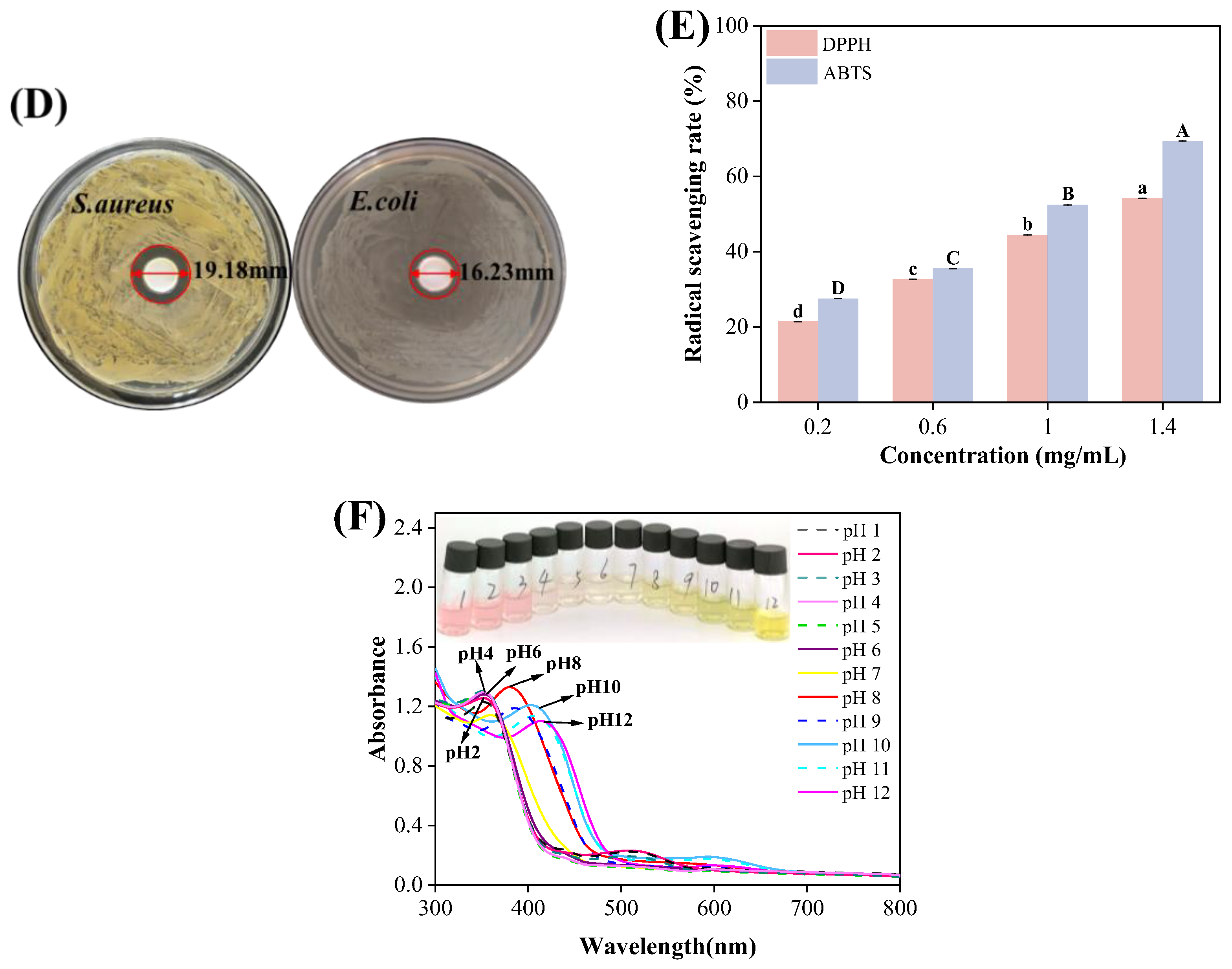


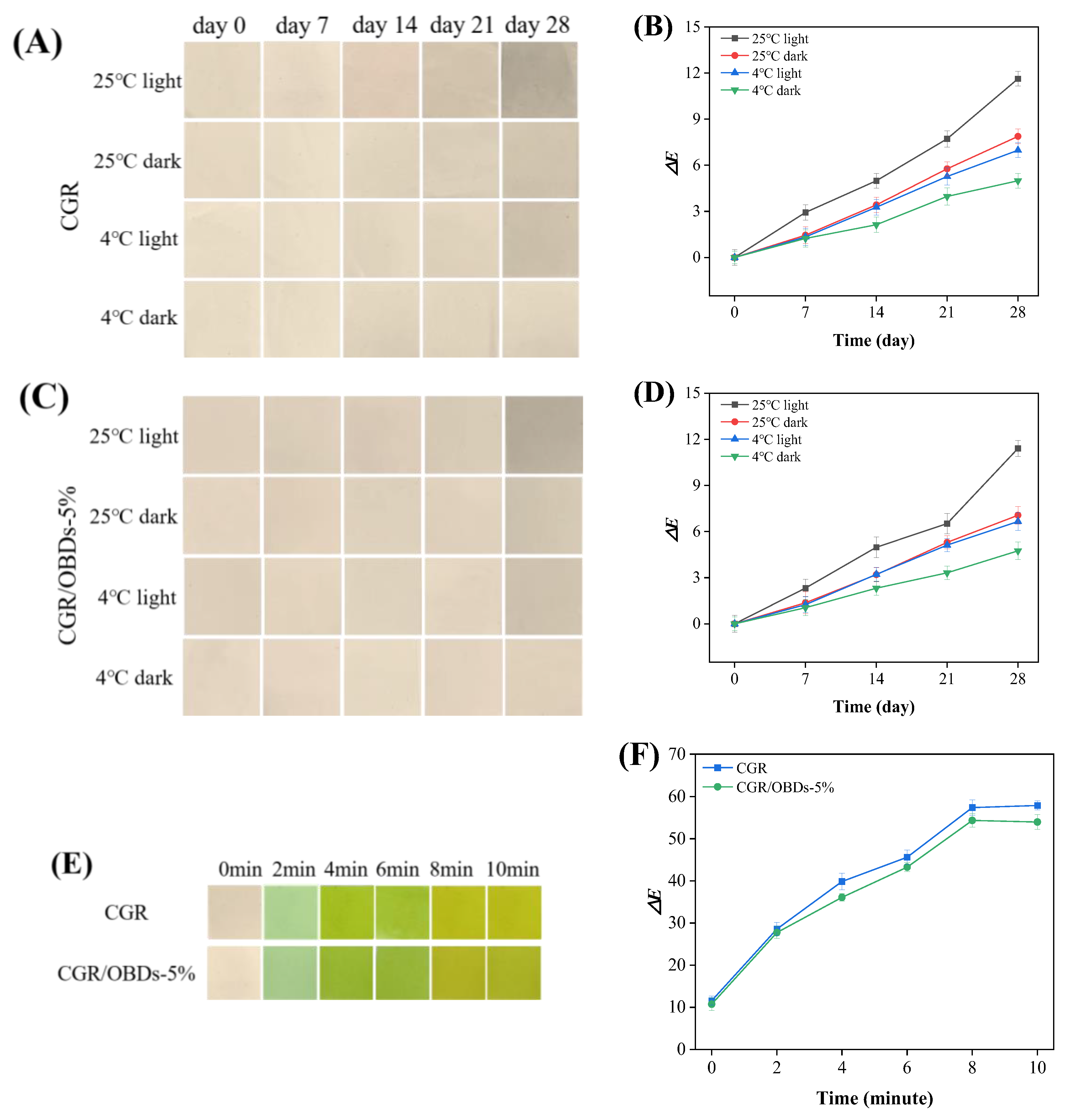
| Film | pH 2 | pH 4 | pH 6 | pH 7 | pH 8 | pH 10 | pH 12 | |
|---|---|---|---|---|---|---|---|---|
| CGR | Color |  |  |  |  |  |  |  |
| L* | 83.94 ± 0.08 e | 85.41 ± 0.05 b | 87.54 ± 0.18 a | 85.17 ± 0.38 b,c | 84.51 ± 0.19 c,d | 83.55 ± 0.47 e | 80.55 ± 0.15 f | |
| a* | 6.68 ± 0.24 a | 2.48 ± 0.05 b | 1.53 ± 0.05 c | 1.08 ± 0.01 d | −1.68 ± 0.08 e | −2.85 ± 0.11 f | −4.82 ± 0.16 g | |
| b* | 8.56 ± 0.30 g | 10.12 ± 0.04 f | 11.13 ± 0.12 e | 13.29 ± 0.21 d | 17.90 ± 0.04 c | 19.85 ± 0.11 b | 30.95 ± 0.22 a | |
| ΔE | 16.42 ± 0.19 e | 15.57 ± 0.13 f | 13.23 ± 0.08 g | 17.11 ± 0.09 d | 21.16 ± 0.14 c | 23.40 ± 0.33 b | 34.66 ± 0.15 a | |
| CGR/ OBDs-5% | Color |  |  |  |  |  |  |  |
| L* | 88.81 ± 0.31 a | 85.06 ± 0.48 c | 86.83 ± 0.45 b | 85.39 ± 0.15 c | 82.36 ± 0.02 d | 82.78 ± 0.13 d | 79.52 ± 0.37 e | |
| a* | 3.68 ± 0.17 a | 3.28 ± 0.11 b | 2.75 ± 0.12 c | 0.98 ± 0.08 d | −3.04 ± 0.05 e | −4.25 ± 0.09 f | −5.43 ± 0.06 g | |
| b* | 6.87 ± 0.01 g | 9.38 ± 0.04 f | 10.40 ± 0.07 e | 12.68 ± 0.05 d | 18.43 ± 0.04 c | 21.74 ± 0.21 b | 27.04 ± 0.09 a | |
| ΔE | 15.51 ± 0.27 e | 13.41 ± 0.30 f | 10.70 ± 0.15 g | 16.49 ± 0.06 d | 22.72 ± 0.11 c | 25.80 ± 0.18 b | 31.09 ± 0.58 a |
Disclaimer/Publisher’s Note: The statements, opinions and data contained in all publications are solely those of the individual author(s) and contributor(s) and not of MDPI and/or the editor(s). MDPI and/or the editor(s) disclaim responsibility for any injury to people or property resulting from any ideas, methods, instructions or products referred to in the content. |
© 2025 by the authors. Licensee MDPI, Basel, Switzerland. This article is an open access article distributed under the terms and conditions of the Creative Commons Attribution (CC BY) license (https://creativecommons.org/licenses/by/4.0/).
Share and Cite
Yan, Z.; Wang, K.; Xia, B.; Wu, J.; Chen, H. Development of Intelligent and Active Gelatin-Based Packaging Film Incorporating Red Onion Anthocyanins and Encapsulated Citronella Oil. Foods 2025, 14, 3320. https://doi.org/10.3390/foods14193320
Yan Z, Wang K, Xia B, Wu J, Chen H. Development of Intelligent and Active Gelatin-Based Packaging Film Incorporating Red Onion Anthocyanins and Encapsulated Citronella Oil. Foods. 2025; 14(19):3320. https://doi.org/10.3390/foods14193320
Chicago/Turabian StyleYan, Zhaolan, Kun Wang, Bingbing Xia, Jintao Wu, and Hongxu Chen. 2025. "Development of Intelligent and Active Gelatin-Based Packaging Film Incorporating Red Onion Anthocyanins and Encapsulated Citronella Oil" Foods 14, no. 19: 3320. https://doi.org/10.3390/foods14193320
APA StyleYan, Z., Wang, K., Xia, B., Wu, J., & Chen, H. (2025). Development of Intelligent and Active Gelatin-Based Packaging Film Incorporating Red Onion Anthocyanins and Encapsulated Citronella Oil. Foods, 14(19), 3320. https://doi.org/10.3390/foods14193320







